- Karl Heiner
 Since the first film was shot and developed, black and white has been a favorite choice among master photographers around the globe. Why is it that this medium is preferred by so many fine artists and masters of the trade?
Since the first film was shot and developed, black and white has been a favorite choice among master photographers around the globe. Why is it that this medium is preferred by so many fine artists and masters of the trade? - It's classic and elegant, even romantic and special.
- When learning photography, the simplicity of black and white helps you focus on the important stuff.
- You can often turn a drab color shot into an amazing black and white.
- If you do your own darkroom work - traditional or digital - it opens up a world of magic and fun.
It's Classic and RomanticWhen people look at a black and white photograph, they often remark how "classic" and "elegant" it looks. For example, it remains to this day a popular choice for weddings. Headshots of CEOs and company presidents - destined for some annual report or other investor brochure - are also often shot in black and white.
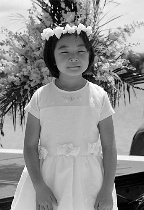 Black and white prints have a refined quality about them. The simplicity and uncluttered look give the subject a polished, high-class feel. Without the distractions of color, the picture begs each viewer to recognize the individuality and uniqueness of the subject.
Black and white prints have a refined quality about them. The simplicity and uncluttered look give the subject a polished, high-class feel. Without the distractions of color, the picture begs each viewer to recognize the individuality and uniqueness of the subject. Another reason why brides often ask for black and white is that it most clearly expresses the romantic. They know that there is something special about it. It has style. The most famous romantic images - Eisenstaedt's sailor kissing a nurse; Doisneau's couple kissing near a French hotel; Erwitt's lovers kissing in a rear-view mirror in California - have been bestsellers for years because they define the romantic.
Learning Graphic Concepts: Tips on Taking Black and White Pictures
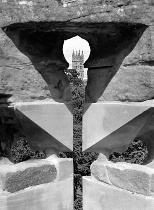 Black and white helps to learn the basics without getting too distracted; this is one reason why it is so popular among teachers. Black and white focuses the attention on form, shading, pattern, and other graphic concepts, to give them an unusual quality with tone and hue.
Black and white helps to learn the basics without getting too distracted; this is one reason why it is so popular among teachers. Black and white focuses the attention on form, shading, pattern, and other graphic concepts, to give them an unusual quality with tone and hue. With a clear view toward graphics, composition, and design, the photographer can concentrate on:
- How contrast creates lines and how lines lead the eye or psychologically affect the viewer by curving, lying flat, diagonal, or vertical.
- How shapes or lines make a pattern and how shape with texture gives an object form.
- How highlights compete for attention and dark tones create an important negative space.
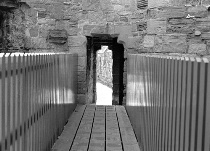 Seeing the reoccurring pattern, line, or shape is easier with black and white, which does such a good job of emphasizing it. This is especially the case when a black and white photo shows good contrast - when the blacks are black, the highlights are bright, when you can still see some detail in both the highlights and the shadows.
Seeing the reoccurring pattern, line, or shape is easier with black and white, which does such a good job of emphasizing it. This is especially the case when a black and white photo shows good contrast - when the blacks are black, the highlights are bright, when you can still see some detail in both the highlights and the shadows. All photographs - not just those labeled "abstracts" - are only two-dimensional representations, or abstractions, of a three-dimensional scene. Black and white makes a photograph even more of an abstraction by removing the distracting qualities of color and allowing us to concentrate on the graphic elements.
Take a look at how different an abstract photo looks in black and white. With the color removed from the overall expression, the shapes of the leaves and the lines in them take on more significance. The graphic concepts are easier to see:
When Black and White Works Better Than ColorSome things just look better when shot in black and white. With it, you can find interest in everyday objects and scenes around you. What might appear boring when shot in color suddenly becomes fascinating when captured in black and white.
Here are a couple of situations which especially benefit from black and white:
Overcast Days
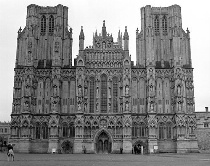 It can be so disappointing to get pictures back from a trip or a shoot to discover they look boring and washed out because the skies were a bright overcast gray. If you choose to shoot the same scene with black and white, you will often get great results; the focus moves to the forms and patterns and away from the dull white of the sky.
It can be so disappointing to get pictures back from a trip or a shoot to discover they look boring and washed out because the skies were a bright overcast gray. If you choose to shoot the same scene with black and white, you will often get great results; the focus moves to the forms and patterns and away from the dull white of the sky.  Black and white is simply fantastic for these kinds of days. The bright, overexposed sky, often blown out in both color and black and white, becomes much easier to ignore. Instead of noticing a dull sky, the viewer sees your intended subject, whether it be a person, an object, or an interesting place.
Black and white is simply fantastic for these kinds of days. The bright, overexposed sky, often blown out in both color and black and white, becomes much easier to ignore. Instead of noticing a dull sky, the viewer sees your intended subject, whether it be a person, an object, or an interesting place. Portraits
 Black and white also works very nicely for portrait photography. Skin tones, in black and white, are mellowed; blotches, blemishes, and uneven shading is less easily noticed than it is in color photos. Our eyes are very critical of facial skin tones in color but, when we examine black and white, we cannot evaluate the tones with the same critical eye.
Black and white also works very nicely for portrait photography. Skin tones, in black and white, are mellowed; blotches, blemishes, and uneven shading is less easily noticed than it is in color photos. Our eyes are very critical of facial skin tones in color but, when we examine black and white, we cannot evaluate the tones with the same critical eye. The Fun That Can Be HadYou can set up your own darkroom to process and print your own images. Like many, you may find it magical to see an image appear out of nowhere in your film or on a print. Developing your own film can be as fun as an art project is to a preschooler. Especially if you are a do-it-yourselfer, hands-on, tactile kind of person, you will get a kick out of mixing potions, clipping film, and seeing your pictures come out of nowhere. Without color to think about, this process is much simpler in black and white than with color film. You can also color select portions of a black and white by using products such as Marshall's photo paints.
Black and white is a predominant choice among masters because it tells the graphic story clearly; it is conducive to learning the art; it connotes a classic fineness; and it is plain and simple fun.

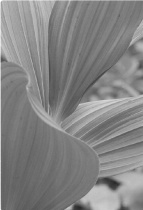
No comments:
Post a Comment